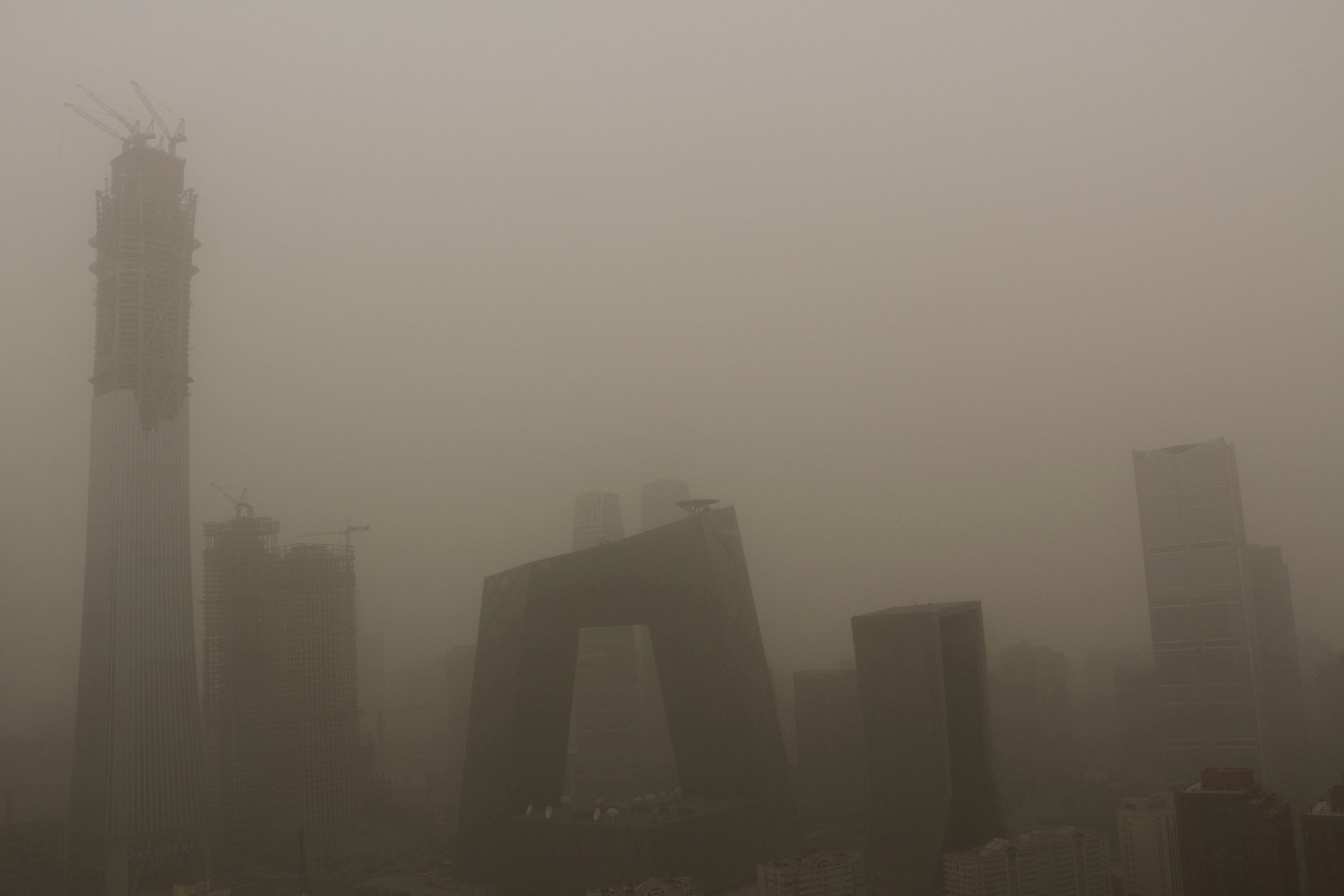
Masks were donned, and air purifiers cranked up to max, as Beijing’s chronic air pollution returned Thursday, shrouding the city’s skyline in a thick pall, and sending residents scurrying for cover as airborne particle ratings breached 20 times WHO safe levels.
Exacerbating the customary deluge of smog from factories and coal-burning power plants was a large sandstorm, a seasonal phenomenon caused by spring winds whipping up the nearby Gobi Desert and depositing its fine dust on the sprawling Chinese capital of 21 million.
As a result, levels of PM2.5 — microscopic particles that can cause breathing and circulation problems and even premature death — reached a staggering 630, while readings of the larger and similarly hazardous PM10 particles were off the scale at 1,000. (The WHO sets 24-hour mean safe levels at 25 and 50 respectively.)
Stay-at-home mom Pan Jia, 31, made her five-year-old daughter wear a face mask on the way to kindergarten this morning. “They have an air purifier and hopefully she can stay in the classroom for the whole day,” she says. “The air really is terrible.”
Children and the elderly have been told to stay indoors, and drivers instructed to take extra precautions on the road, as the government issued a “blue alert” for the sandstorm, which also affected huge swaths of the nation’s populous northeast.
To help tackle sandstorms, 32 million acres of new forest have been planted since 2008 in the northern Gobi Desert, according to the State Forestry Administration. As a result, sandstorms have become less frequent and intense. (Two storms in March 2002 deposited 56,000 tons of dust on Beijing.)
“When I was young, there were more sandstorms in Beijing, but we didn’t know the harm,” adds Pan. “After every [exercise] class outdoors I could feel the sand between my teeth.”
Social media has been abuzz with photos of off-the-scale pollution meters, sand piled on cars and face-mask selfies, taken in front of walls of smog. Companies selling air purifiers seized on the opportunity to hawk their products.
“It’s hard for Beijing to handle the air pollution,” posted one user to China’s Twitter-like microblog Weibo. “If the north wind comes, the smog is gone, but the sand storm comes. Without the north wind, the sand won’t come, but the smog is hard to clear. I wish some official could find a smart solution.”
China’s pollution contributes to 1.6 million deaths each year, according to a recent study, and has become a serious problem for the ruling Communist Party. A fund to combat smog has been boosted 250% this year to $5.8 million, according to the Ministry of Finance, the problem is worsening. Beijing’s PM2.5 readings spiked by 27% over the first quarter of 2017 compared to last year, reports the South China Morning Post.
Thursday’s smog was also likely augmented by a huge forest fire that broke out Tuesday in the Greater Hinggan Mountains in the nearby province of Inner Mongolia. More than 8,300 firefighters are working to extinguish the blaze, according to local authorities, which has engulfed at least 50 sq km of China’s largest forest. The fire originated across the border in Russia.
—With reporting by Yang Siqi / Beijing
More Must-Reads From TIME
- The 100 Most Influential People of 2024
- Coco Gauff Is Playing for Herself Now
- Scenes From Pro-Palestinian Encampments Across U.S. Universities
- 6 Compliments That Land Every Time
- If You're Dating Right Now , You're Brave: Column
- The AI That Could Heal a Divided Internet
- Fallout Is a Brilliant Model for the Future of Video Game Adaptations
- Want Weekly Recs on What to Watch, Read, and More? Sign Up for Worth Your Time
Write to Charlie Campbell / Beijing at charlie.campbell@time.com